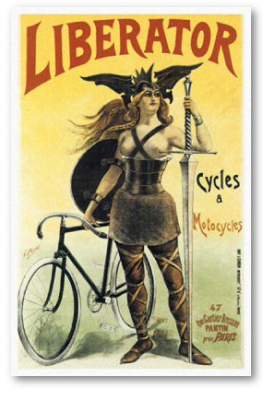A person uses a piece of software, a Web site, or any other product — “virtual” or “real” — to achieve a goal. The design of interaction with these products can either help or form obstacles that interfere with the realization of that goal. A product is easier to use when its interaction is designed to meet the needs of its intended audience. Product designers who consider those needs produce far more effective interaction solutions than those who base their designs on aesthetics or business needs alone. But how does one go about “considering” user needs and then come up with a design solution that works? Oscar Wilde famously said: The pure and simple truth is rarely pure and never simple. Pure and Simple design is similarly rarely pure and never simple to develop. I my class, Cognitive tools for Product Designers, we explore what users bring to usability. We all arrive at the scene with different baggage — our experiences, education, perception, memory, and so on are unique to each of us. No two individuals interpret an experience in exactly the same way. While this sounds daunting, we shouldn’t give up on design all together. We all have some…
Scaffolding
Cognitive Blindness, Pipsqueak Articles, Product Design Strategy, Scaffolding
Using Positive Emotion to Change Behavior
by Olga Werby •
Games can be used to change our behavior — make something fun, and we are likely to do it again and again. Psychologists call is positive reinforcement. Pleasure triggers our amygdalas — makes us make strong neural connections between the activity and positive emotion. Thrills are memorable and we seeks them out in our daily lives. Here are two examples of using fun to change people’s behavior, to make us do something we ordinarily don’t particularly want to: climb stairs and recycle. November 17th Update A fellow member of the Human Factors and Ergonomics Society (HFES), David Watts, recommended the following:
Conceptual Design, Pipsqueak Articles, Product Design Strategy, Scaffolding, Users
Special Preview: Social Media by Thomas Erickson
by Olga Werby •
Interfaces.com was given a free advanced preview of Thomas Erickson’s report and videos on social computing. The videos are very well produced and provide an interesting point of view and good insights on social media. Below are few of my notes based on the video content and ideas discussed on this blog in the past (my former students should find these familiar). Social Media Definitions & Ideas Social Computing: this is really about groups working together using ICT (Information Communication Technologies). I think this is a broader definition then the one offered by Thomas Erickson, as it includes all forms of ICT. Social Scaffolding: we all have a set of social scripts — culturally-specific, socially constructed norms of behavior — that help us navigate group interactions and allow for self-organization of crowds, at least shot-term and for a limited goal (like crossing the street). [Please watch Dr. Erickson’s example of street crossing in “Video 4.3: Social Computing video 3 – Face-to-face Interaction as Inspiration for Designing Social Computing Systems”.] Product design needs to create opportunities for social interaction — these scaffolds have to be built into the system: meeting spaces, places to sit down, well-lit areas, easy communication tools, games,…
Interaction Design, Interface Design, Pipsqueak Articles, Scaffolding
Passionate Interface: Siri Inspires Love
by Olga Werby •
You know your product is succeeding with its users when, within days of its launch, they write love songs to your work. Check out this love ode to Siri, Apples latest interface update.
Conceptual Design, Featured, Flow, Pipsqueak Articles, Product Design Strategy, Scaffolding, Users
Fun, Functionality, Flow: the 3 F’s of Product Design
by Olga Werby •

Good product design—design that solves a real need; design that considers the strengths and weaknesses of the user; design that stands the test of time and cultural fads—always incorporates the the 3 F’s: Fun, Functionality, and Flow. It’s easy to talk about the 3 F’s in abstract, but I thought taking a concrete example of a bicycle would be more productive. A bicycle is a designed object that satisfies a real need, does so in way that brings joy to its users, and the act of riding results in flow experience for many. The old “Liberator” poster tries to communicate all 3 F’s to the potential buyers of its products: liberator means freedom to move, real functionality; the woman warrior communicates power and fun—you will feel the way she looks! It’s exhilarating! Notice the high heels and the beautiful vista (with a rough terrain) and a kid pointing at the riders with envy. These posters, old advertising ads for bicycles, try to communicate the same: it’s fun, functional, and exciting to ride a bike. Ride, and look good. Ride, and be the center of attention. Design for Fun So what makes a particular design fun? It seems that one of…
Conceptual Design, Cultural Bias, Flow, Interaction Design, Interface Design, Language, Perception, Pipsqueak Articles, Product Design Strategy, Scaffolding, Working Memory
The Haptic Feel of Books versus eBooks
by Olga Werby •

We’ve traveled to Rome for our family vacation this year, and aside from a few summer reading books that I couldn’t find in an eBook format, we relied on our two Kindles and 3 iPads for our family reading needs. This is the second summer we brought primarily electronic versions of books—”The Count of Monte Cristo” is much easier to read when it fits into your hand and doesn’t weigh a ton… In the days before the Kindle and iPad, we carried an extra suitcase just for books. But there are drawbacks to buying and reading eBooks. Below are some of my thoughts and experiences—the cogitations of a voracious reader. Time & Progress As I was reading my novels, I found myself repeatedly trying to figure out where in the book I was. How far along was I? When is the next natural break (chapter, section end)? How many pages are there to the end of the chapter, end of the section, end of the book? These were not idle curiosities about my reading accomplishments, although when you do finish reading the book version of “The Count of Monte Cristo”, you do have a sense of having read something. An…
Cultural Differences, Pipsqueak Articles, Product Design Strategy, Reference, Scaffolding, Users
Generation C, a Sample User Persona
by Olga Werby •
Here’s an Booz & Company article by Roman Friedrich, Michael Peterson, Alex Koster, and Sebastian Blum: “The Rise of Generation C Implications for the World of 2020.” [contact information for the authors is available inside the PDF] The Rise of Generation C
